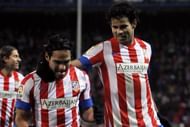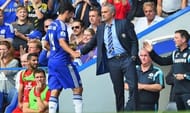On a cold November night in 2013, Diego Simeone’s groundbreaking Atletico side was at its ruthless best against a helpless Getafe in the Vicente Calderon. Even with a 4-0 lead against 10 men, Atletico pressed their opponents with tireless aggression, as they attempted to keep pace with the two eternal heavyweights of the Spanish game – one from Catalonia and the other from across the street.
In the 69th minute, captain Gabi got the ball on the right wing and took a quick glance towards the penalty area. All he could see was the sturdy 1.88m frame of a certain Diego Costa powering through the centre, outnumbered against two of Getafe’s centre backs. Gabi’s delicious cross had just the right amount of power, but it was curling a few inches away from Costa, who looked like he had overrun it.
What he did in the next few seconds got him not just the best out of seven delicious Atletico strikes that night, but also led to that special bit of skill being nominated for the Ferenc Puskas goal of the year award. Even Getafe’s keeper Codina stood rooted to his spot, unable to process the sheer ingenuity and technical brilliance of the effort.
In many ways, that goal comes closest to defining the 26-year-old Spaniard – unorthodox, outrageous, yet supremely effective. It does not matter if Costa is outnumbered or out of position; he embodies the very essence of a centre forward’s responsibility – do whatever with the input and produce the required output.
It is this combination of unpredictability and remarkable footballing instinct that has made Diego Costa into the monster that he is, one of the most complete forwards in the game today. It is difficult not to admire a player of Costa’s calibre.
Ruthlessly industrious, Costa presses like a mad bull placed on a football pitch. Be it chasing hopeless clearances to hustle defenders, or colliding knee first into a goal post to score a crucial second goal against Getafe like he did in April 2014, his physical prowess is matched by his staunch mental resilience and perseverance. As Atletico Madrid did the unthinkable by beating their more illustrious competitors in the 2013/14 season, Costa’s contribution to the cause was unquestionable and indispensable.
A late bloomer
Costa’s steady climb to the top of Atletico’s pecking order was anything but easy. By the age of 16, most prodigies are well on their way to footballing greatness, but Costa was still playing football on the streets of Brazil.
Signing for Portuguese club Braga in 2006, he made no league appearances for the club and was consigned to the reserve squad. After Atletico bought him in 2007, he was loaned out to three clubs in the Spanish second division, was sold by Atletico to Valladolid, had a knee injury that led to him failing a medical for a transfer to Besiktas and then came back to Atletico the following season.
He played second fiddle to Atletico’s forward-forging legacy which included Diego Forlan, Sergio Aguero and Radamel Falcao. Add to that switching allegiances from playing for Brazil to playing for the Spanish World Cup side in Brazil, and Costa has pretty much had to brave it all. It is this continuum of enduring obstacles that has perhaps added to Costa’s unshakeable mental strength.
Consequently, Atletico’s team, up until last season, was never built around him. Costa was always forced to incorporate himself into systems with strengths that weren’t necessarily congruent with his own. He was used as an inside forward at Vallecano, using his pace to cut inside from the left wing to shoot; it was a position he adapted to very well as he scored 10 goals in 16 appearances.
The peak of his footballing education though came under Simeone, who recognized the dormant potential of Costa’s varying skill sets. Under the tutelage of El Cholo, Costa finally found a tactical system that played to his strengths – aggressive pressing in high areas, lightning swift counters and the responsibility of holding up the ball to play in runners from deep.
Simeone realized that having started his playing career later than most, Costa was still learning to pick up the finer aspects of tactics and forward play. He was further helped by Simeone’s decision to pair him with Falcao, a move which benefitted both forwards and the team as a whole.
Costa was encouraged to drift wide to utilize his experience on the wings, simultaneously creating space for Falcao to exploit. The Colombian would often drop deep and allow Costa to make forward runs; that fluidity in the forward ranks yielded 54 goals from the front two alone that season. After Falcao’s departure for Monaco the next season, Simeone had seen enough to decide that Costa was ready to be the fulcrum of the Atletico attack.
With the advanced role now at his disposal, all goal-scoring responsibilities were placed firmly on the shoulders of the fiery forward. Costa responded by scoring 35 goals in just 43 starts, including eight from nine games in Atletico’s Champions League campaign. Effectively, Costa’s learning curve was similar to that of Thierry Henry, who at one time was forced to ply his trade on the wings at Juventus in spite of preferring a more central role.
Once Henry was entrusted with the role of playing in the middle, the Frenchman was hailed as the ideal centre forward in the modern game, a goal-scorer who was equally comfortable working the flanks. Although Costa’s goal count was significantly lower, the consequences of acquiring diverse attacking dimensions were there for everyone to see.
The missing piece in Mourinho’s puzzle
After his fine exploits in Atletico’s incredible La Liga triumph, Chelsea came calling for Costa’s services. The void left by Didier Drogba had consistently derailed the Blues’ title ambitions, and Jose Mourinho hoped that 32 million pounds would help provide some much-needed firepower up front. The Portuguese manager was known to admire hard-working individuals who could adapt to multiple positions, and from the start Costa and Chelsea seemed like a match made in heaven.
He began with seven goals in his first four games, bettering the six goals in four that Sergio Aguero managed for Manchester City on his transfer from Atletico. But it is not just Costa’s goals that have transformed Chelsea’s fortunes this season. Once again, Costa’s willingness to adapt into a highly interchangeable forward line has made all the difference.
Recognizing the presence of world class wingers in Eden Hazard and Willian and a diminutive magician in Oscar, Costa has gone from taking full attacking responsibility to learning to share it. Sergio Aguero’s 14 goals this season have come from five shots a game, while the Chelsea hitman has taken closer to three per game to produce the same number of goals.
Costa’s 1.8 key passes a game are matched only by Lyon’s talisman Alexandre Lacazette, and is almost twice as much as the number of key passes made by Sergio Aguero, QPR’s Charlie Austin, Hoffenheim’s Alex Meier, Marseille’s Andre-Pierre Gignac and even Barcelona’s Neymar (all of them are currently among the top 10 scorers in Europe’s prime leagues this season).
What is truly an enticing proposition is that Costa could yet make a more substantial tactical impact in the games to come. Thanks to his experience of playing in different positions, Mourinho’s keen tactical acumen could yet see him employ the Spaniard in different roles to help overcome certain challenges.
Against Paris Saint German in the Champions League last season, Mourinho used Andre Schurrle as a false nine in a bid to add numbers to counter PSG’s excellent midfield trio of Thiago Motta, Blaise Matuidi and Marco Veratti. The tactic seemed to work until the moment Schurrle was taken off, as Chelsea eventually lost the first leg.
At around the same time last season, Simeone employed David Villa and Costa in similar, withdrawn roles against Real Madrid. The compact and narrow nature of the formation effectively choked Real’s excellent central midfield, as Costa’s runs from deep caused Los Blancos numerous problems on the night. With two withdrawn strikers, Real’s centre-backs were left baffled as to who to mark, and were eventually pulled out of position to allow Costa to slip in behind.
That alternative is available to Mourinho this time around, as they face PSG once again in the knockout phases. The tactic will allow Mourinho to similarly negate PSG’s midfield and allow Costa to make those trademark powerful runs at the likes of David Luiz, who is prone to going out of position and leaving spaces behind him.
Costa’s intelligent movement and physical exchanges may not seem as elegant next to Eden Hazard gliding on the pitch or an effortless series of stopovers by Willian. But the Spaniard has proved over the past couple of years that he is the polished, finished deal that every team would love to have.


